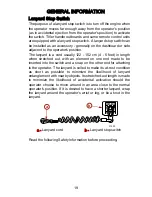
GENERAL INFORMATION
29
Know and obey all nautical rules and laws of the waterways. Boat
operators should complete a boating safety course. Courses are
offered in the U.S.A. by 1) The U.S. Coast Guard Auxiliary, 2) The
Power Squadron, 3) The Red Cross and 4) your state boating law
enforcement agency. Inquiries may be made to the Boating
Hotline, 1‑800‑368‑5647 or the Boat U.S. Foundation information
number 1‑800‑336‑BOAT.
Make sure everyone in the boat is properly seated. Do not allow
anyone to sit or ride on any part of the boat that was not intended
for such use. This includes the back of seats, gunwales, transom,
bow, decks, raised fishing seats, any rotating fishing seat; or
anywhere that an unexpected acceleration, sudden stopping,
unexpected loss of boat control, or sudden boat movement could
cause a person to be thrown overboard or into the boat.
Never be under the influence of alcohol or drugs while boating (it
is the law). Alcohol or drug use impairs your judgment and greatly
reduces your ability to react quickly.
Prepare other boat operators. Instruct at least one other person on
board in the basics of starting and operating the outboard, and boat
handling, in case the driver becomes disabled or falls overboard.
Passenger boarding. Stop the engine whenever passengers are
boarding, unloading, or are near the back (stern) of the boat. Just
shifting the outboard into neutral is not sufficient.
Be alert. The operator of the boat is responsible by law to maintain
a proper lookout by sight and hearing. The operator must have an
unobstructed view particularly to the front. No passengers, load,
or fishing seats should block the operators view when operating
the boat above idle speed.
Never drive your boat directly behind a water skier in case the skier
falls. As an example, your boat traveling at 40 km/h (25 MPH) will
overtake a fallen skier 61 m (200 ft.) in front of you in 5 seconds.
Watch fallen skiers. When using your boat for water skiing or
similar activities, always keep a fallen or down skier on the
operator's side of the boat while returning to assist the skier. The
operator should always have the down skier in sight and never
back up to the skier or anyone in the water.















































